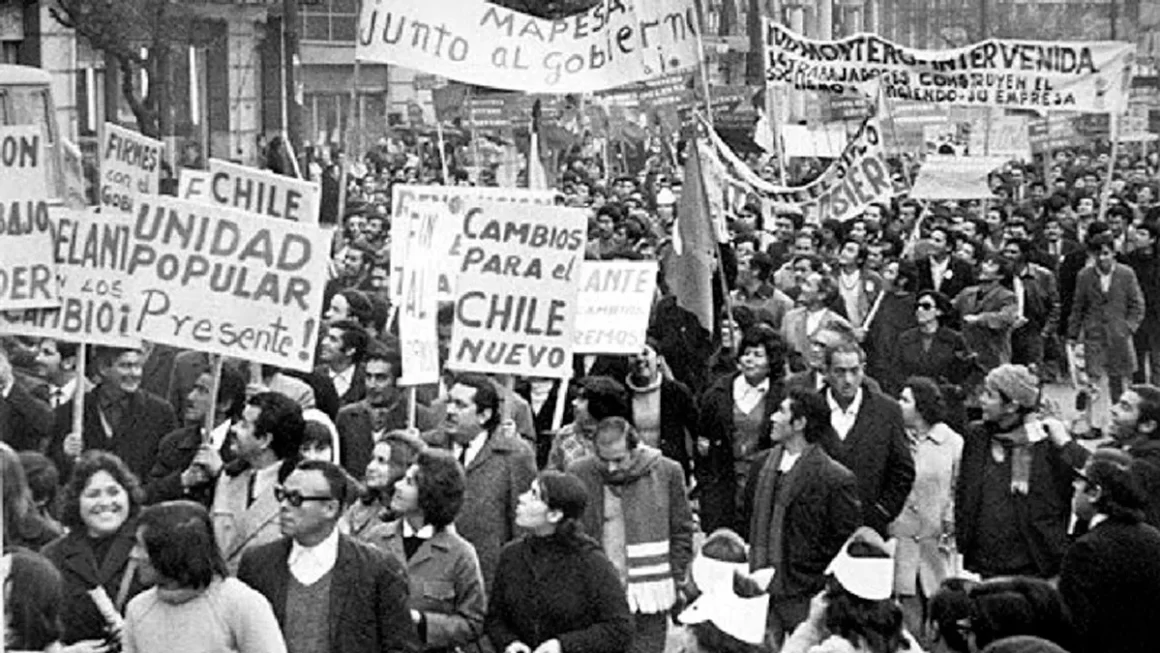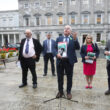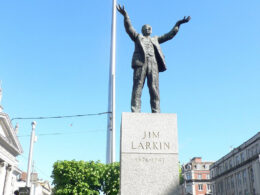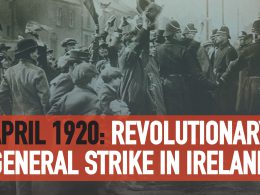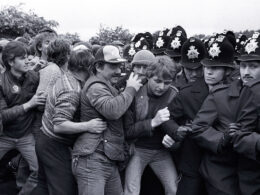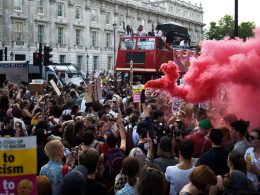By Darragh O’Dwyer
“Workers of my country, I have faith in Chile and its destiny. Other men will overcome this dark and bitter moment when treason seeks to prevail. Go forward knowing that, sooner rather than later, the great avenues will open again and free men will walk through them to construct a better society.”1
These words were uttered by Salvador Allende in a final address before his death on 11 September 1973. General Augusto Pinochet had launched his coup, bombarding the presidential palace and beginning the systematic slaughter of the thousands of working-class militants that had spearheaded the revolutionary process now coming to a bloody end. Workers, youth and the oppressed had posed an existential threat to Chilean capitalism and sent shivers up the spine of US imperialism. They were now paying the price. But more than ‘a dark and bitter moment’, the overthrow of Allende’s Popular Unity Government inaugurated a long night of military dictatorship – a brutal regime that would last until 1990.
Now on the 50th anniversary of the coup, world capitalism is convulsed in a maelstrom of social, political and economic crises. Latin America regularly finds itself at the epicentre. And since 2019 ‘great avenues’ have indeed opened again. A wave of popular uprisings have swept the region – revolts against the neoliberal order trialled and incubated under the Pinochet dictatorship before becoming the dominant policy and ideology of the capitalist classes the world over. In Chile itself, a social explosion shook the system to its foundations, calling into question all the economic and political remnants of that outlived dictatorship. As one slogan put it: “Neoliberalism was born here and neoliberalism will die here.”
Imperialism and Chilean capitalism
Prior to the Pinochet regime, Chile was regarded as an outlier of stable bourgeois democracy in a region otherwise wracked by conflict, coups and dictatorships. Indeed, this supposedly unique character of Chilean democracy influenced how Allende framed his parliamentary road to socialism. But despite the accolade of ‘the England of South America’, Chile remained a fundamentally underdeveloped economy, pillaged and dominated by colonialism and imperialism.
As in the rest of Latin America, the vicious Spanish conquest saw Chile become incorporated into the mercantile capitalism of the 1500s, a colonial economy geared towards the production of primary exports. This gave rise to a powerful class of landlords concentrated in Chile’s Central Valley. Of European descent, they ruled over private estates, or haciendas, populated by indigenous peoples labouring in conditions of semi-slavery.
Even political independence, won in 1818, did not place Chile on the path of independent economic development. The nascent republic remained wholly subservient to the burgeoning industrial capitalism in Europe, supplying the latter with agricultural products and natural minerals. An overreliance on one or two key commodities made the Chilean economy extremely vulnerable to the vagaries of the world market. The onset of world depression in the 1870s hit Chile particularly hard, gutting grain markets and triggering economic and social crises.
But after its annexation of the Atacama desert in 1879 in a war with neighbouring Bolivia and Peru, Chile secured for itself a world monopoly (80% by 1883) on nitrates. Taxes on a booming export industry funded a partial modernisation and strengthening of the state with the development of infrastructure, public education, the army and urbanisation. This, alongside the violent suppression of indigenous rebellions granted Chilean capitalism relative stability for the next period.
Uneven and combined development
Chile was not simply catching up with England and France, passing through a bourgeois democratic revolution at a delayed pace. Rather than confronting the landlords to carry out agrarian reform, the industrial and commercial bourgeoisie completely fused with them into a ruling class united in both their subservience to foreign capital and their opposition to the exploited and oppressed masses. One survey in 1964 indicated that half of all big businessmen either owned farms or had relatives who owned farms.
This character of the Chilean bourgeoisie has remained a constant right up to the present day. Serving as a junior partner to successive imperialist powers, the oligarchy’s enrichment has always been based on facilitating imperialism’s plunder of Chile’s resources. Contrary to the false conception of the Stalinist and reformist left, there was no ‘progressive’ section of the ruling class that could mount a challenge to imperialism and further develop the economy or improve the lives of the masses on the basis of capitalism. As we’ll see later, this view would have fatal political consequences.
In that sense, the patterns of Chile’s uneven and combined development show the relevance of Leon Trotsky’s theory of permanent revolution. As the Russian Revolutionary himself put it in 1932:
“South and Central America will be able to tear themselves out of backwardness and enslavement only by uniting all their states into one powerful federation. But it is not the belated South American bourgeoisie, a thoroughly venal agency of foreign imperialism, who will be called upon to solve this task, but the young South American proletariat, the chosen leader of the oppressed masses.”2
The events that unfolded from 1970-1973 were a negative confirmation of these prescient theoretical insights.
The wakings of the Chilean working class
Indeed, alongside the persistence of semi-feudal remnants, there developed a mining industry that gave birth to a powerful and concentrated working class. While in 1880, 2,484 were employed in nitrate production, by 1890 the number had jumped to 13,060. Accompanying this was a boom in the railways and other connected industries so that by 1900 Chile had an estimated 250,000 industrial workers. A radical labour movement flourished with the emergence of organisations like manocomunales: “part mutual-aid society, part resistance society, part vehicle for the creation and extension of working-class culture.”3 Far from some altruistic motives of the ruling class, it was the militancy and strength of the workers’ movement that secured the (limited) democratic rights that distinguished Chile from its neighbours.
But this thin veil of democracy could not hide the true nature of the exploiters and their political servants. Conditions in the mines were notoriously hellish and workers were regularly met with brutal state repression. Etched into the consciousness of Chilean workers for decades after were the events that unfold in Iquique in 1907 where the army, responding to a general strike, massacred 2,000 workers and their families, exposing the ruthlessness of the Chilean ruling class in their goal of achieving ‘stability’ for foreign investors.
While certainly a setback, this bloody defeat also imparted significant lessons to the workers’ movement, spurring on the development of consciousness and new organisations. 1911 saw the foundation of the explicitly socialist Chilean Workers’ Federation. In 1912, Luis Emilio Recabarren formed the Socialist Workers’ Party, which in 1922 would formally change its name to the Communist Party of Chile and join Lenin’s Third International.
Workers parties
Following Stalin’s rise to power and adoption of the theory of ‘Socialism in One Country’, maintaining the rule of the bureaucratic caste came to dominate over the advancement of the world revolution. Like other sections, the PCCh became increasingly bureaucratised, its policy determined by Moscow’s diplomatic interests rather than those of workers’ and the oppressed in Chile.
The squandering of revolutionary opportunities in the late 20s / early 30s saw a disgruntled layer of militants departing the ranks of the PCCh to establish the Socialist Party of Chile in 1933. An organic expression of the working class searching for a genuine political voice, the party had a vibrant left wing made up of revolutionary elements that continued to be inspired by the Bolshevik revolution and explicitly defended Marxism in its programme.
Salvador Allende was a founding member, radicalised by his experience as a medical student and seeing the clear link between rampant poverty and poor health and disease. But despite his early anarchist education and reading of Marx, Lenin and Trotsky, Allende stood on the party’s reformist wing. In reality they had more in common with the Communist Party who in 1969 laid out in its programme:
“The communist struggle for the unity of our country (a country that has been a victim of the capitalist system), has to carry out, as a first movement, a revolution that is anti-imperialist, anti-oligarchic and anti-feudal. During this stage, the elements of change must be introduced into the mode of production leading to socialism.”4
Here we see the classic stagism of the Stalinists. The first task of the workers’ movement, they argued, was to rid the country of its feudal vestiges, develop a more independent capitalism and only at a later and distant date, begin moving in the direction of socialism. As explained above, Chile’s position on the world market, already dominated by imperialism, meant there was no basis nor desire to carry out an ‘anti-imperialist, anti-oligarchic and anti-feudal’ revolution. But far from a mere academic debate, these theories would regularly be invoked to justify alliances with supposed progressive sectors of the bourgeoisie and limiting the scope and depth of the revolutionary process.
Class struggle heats up
Reflecting a general shift in world relations whereby the US eclipsed Britain as the dominant imperialist power, after the First World War the booming copper industry came to be dominated by US multinationals:
“El Teniente, which produced a third of the national total, went into the hands of a U.S. company in 1904. Chuquicamata was bought by another U.S. company in 1912. This mine produced about half of the national total. In 1927 Anaconda and Kennecott Copper represented one-sixth of national copper production.”5
As the 20th century progressed, US imperialism tightened its grip. Strengthening its economic ties with the Chilean ruling class, by 1968 approximately 70% of all capital goods, like spare parts and machinery, were imported from the US. Foreign debt ballooned from $598 million in 1960 to $3.1 billion in 1970. All of this in tandem with an increase in political and military connections. The Chilean Army received weapons and training from the US, and over 80 private US institutions, including the Ford Foundation, sought to project influence in all aspects of Chilean society.
The sharpening contradictions of Chilean capitalism provoked a heating up of the class struggle, mass radicalization and a crisis in the traditional bourgeois parties. Despite coming to power in 1952 on a populist programme that won the support of the CUT trade union federation and sections of the left, president Carlos Ibáñez quickly displayed his true colours. Confronting the workers’ movement with a combination of concession and repression he defeated a 1956 general strike in order to achieve the necessary ‘stability’ for access to US and IMF loans.
Notwithstanding these setbacks, working-class discontent continued to smoulder and received an electoral expression in the 1958 presidential race. The ruling class was left in shock when Allende, representing FRAP (an electoral coalition of the Socialist Party, Communist Party amongst others, a predecessor to Popular Unity) came second with 28.5% of the vote, narrowly losing out to the National Party’s Jorge Alessandri, president of the CPC bosses’ union. Alessandri pursued free market policies, opening up the country further to US capital and intensifying class conflict in the cities and countryside.
Of course, this period must be seen in the context of the revolutionary uprisings that swept the globe in the same period. 1968 saw a general strike threaten French capitalism; US imperialism faced an increasingly radical Black freedom struggle at home and the heroic resistance of workers and peasants in Vietnam; in Czechoslovakia the Prague Spring challenged the rule of the Stalinist bureaucracy and in Mexico, a titanic student uprising was drowned in blood. Across Latin America workers and youth looked to the 1959 Cuban revolution as a beacon, with Che Guevara becoming a symbol of struggle for all those looking to sweep away landlordism and capitalism.
Even the strategists of US imperialism understood that Latin America was a tinder box that could explode at any moment, potentially sending their investments and spheres of influence up in smoke. Following humiliation at the Bay of Pigs, John F Kennedy established the Alliance for Progress in 1961. This represented a change in style (rather than substance) for American foreign policy. Donning a velvet glove over the iron fist, a section of the US ruling class sought to stave off revolution and repair its image through the promotion of reforms.
In Chile they found their candidate in Eduardo Frei of the Christian Democrats. The radicalization of the masses, the authority of the workers’ parties and prominence of socialist ideas meant the Christian Democrats had to attempt to ‘outflank’ Marxist politics by adopting at times quite radical sounding rhetoric. Winning the presidency in 1964 with 56% of the vote, Frei promised a ‘Revolution in Liberty’ offering a programme of ambitious agrarian reform as well as the ‘Chileanisation’ of the copper mines, a form of partial nationalisation that in practice left big companies in control of the sector.
Frei’s policies remained trapped in the deepening contradictions of Chilean capitalism. Although his reforms were ultimately limited, they nevertheless offended the interests of many big industrialists and landlords who resisted any inroads into their power, profits and prestige. Nor did the ‘revolution in liberty’ quell the anger of the masses. In fact, the raised expectations of workers, peasants and the oppressed stimulated a surge in the class struggle. Towards the end of Frei’s presidency Chilean society was in open ferment. Mapuche indigenous people and peasants seized land in the countryside, pobladores or slum-dwellers carried out urban occupations, and the student movement radicalised sharply to the left. The working class was also on the move: 1,939 strikes involving 230,725 workers in 1969 jumped to 5,295 strikes involving 316,280 workers in 1970.6
Unidad Popular come to power
This is the backdrop to the UP’s rise to power. Formed in October 1969, the Popular Unity (Unidad Popular, UP) coalition consisted of the CP and the SP alongside other small, mostly middle-class parties: MAPU (a left-wing split from the Christian Democrats), API, PSD and the Radical Party. In essence the UP was a ‘Popular Front’, whereby the workers’ parties formed an alliance with bourgeois and petit-bourgeois forces. Although the SP and CP had the largest weight in the coalition, the inclusion of the pro-capitalist Radical Party actually served the interests of the Communist Party, who could justify its reformist policy, citing the need to keep the others on board and win over the middle class. Despite their numerical weakness, Allende would give the Radicals as much weight in his cabinet as the Communists and Socialists.
Also on the left but not joining the UP was Moviemento de Izquierda Revolucionaria (MIR), a group formed in 1965 made up predominantly of students who, under the influence of the ideas of the Cuban Revolution, split from the Socialist Party. Led by Miguel Enríquez, in 1969 they adopted a guerilla strategy, a posture which they changed after Allende’s victory.
In September 1970, the UP won 36.2% of the vote in the presidential elections, narrowly defeating Alessandri who got 34.9%. The Christian Democrats ran a more left candidate, Tomic, who received 27.8%. Popular Unity had won a plurality, but not an outright majority. Outnumbered in congress, Allende sought the backing of the Christian Democrats to assume the presidency. This came at a price. Allende agreed to a number of conditions that would place strict limits on his government, including not making any changes to the army, navy, air force or police. Likewise he agreed not to interfere with the freedom of the press – in other words give free rein to the mass media, owned by the ruling class, and used to spread all manner of lies and slander to damage the government.
Marxist theory of the state
This is an early but vivid example of Allende’s false understanding of the capitalist state. It is not that he was unaware of the Chilean state’s record in dealing with striking workers. Rather, he made the mistake of thinking that, based on the peculiarities of Chile’s political system, it could somehow be adapted to the ends of the new government. In his first speech to Congress he stated:
“The flexibility of our institutional system allows us to hope that [the state] will not be a rigid barrier of contention. And just as in the case of our judicial system, it will adapt to new needs in order to generate, through constitutional means, a new system of institutions required by the superseding of capitalism.” (Our emphasis)7
The words of Marx, reflecting on the experience of the 1871 Paris Commune can almost be read as a direct rebuttal to Allende: “the working class cannot simply lay hold of the ready-made state machinery, and wield it for its own purposes.”8 Yet this is precisely what Allende sought to do. He failed to grasp that the state and its institutions are not neutral, but an instrument forged and wielded by the ruling class to maintain its dominance over a deeply unequal society riven by contradictions. “Special armed bodies of men” as Engels described it, required to repress, discipline and keep in check the exploited and oppressed.
Moreover, in Chile, as elsewhere, the upper echelons of the state – the generals, top civil servants and judges – were completely interwoven with landlords, industrialists and bankers, attending the same elite schools and often coming from the same families. Would these figures remain loyal to a project that threatened their very existence? As we’ll see, the false idea that they would somehow act independently from their social class was exposed by the tragedy of ‘73.
This was also one of the many instances over the next three years where, instead of relying on the revolutionary initiative of the masses, Allende sought to appease the bourgeoisie through parliamentary manoeuvres – give a concession here and there in the hope you could win them over. Allende preferred the working class to play a passive role and go along with a stage-managed process from above. Nevertheless, that would be easier said than done.
The electoral defeat of the Chilean oligarchy and the coming to power of a left government enormously boosted the confidence of the working masses, who would regularly run ahead of their leaders in understanding what needed to be done.
Policies of Unidad Popular
While falling short of a break with capitalism, the policies of the UP and the social forces that stood behind it represented a real threat to the ruling class. Popular policies immediately alleviated the conditions of the working class such as freezing of rents and prices, wage and pension increases and, famously, the free distribution of milk to all school children to combat malnutrition. Likewise, they implemented the agrarian reform first brought forward by the Frei government but blocked by Congress. The April 1971 municipal elections showed a rise in support for Popular Unity, which won almost 50% of the vote. Most significantly, it was a resounding endorsement of those perceived as the most radical elements of the coalition, the Socialist and Communists who increased their vote, while the Radical Party actually dropped support.
In July 1971, much to the fury of US imperialism, Chile nationalised the copper industry without compensation, alongside other key sectors of the economy: 150 of 3500 firms were taken into the “social property sector.” While representing a real blow to the oligarchy, these policies nevertheless left 50-60% of industrial production in the hands of the Chilean oligarchy. This strategy was falsely justified on the basis that moving too rapidly in the direction of socialism would provoke reaction. But the revolutionary process is not a tap that can be turned on and off, and the masses pushed on in taking matters into their own hands.
Initiative from below
Illegal land occupations continued to rise, the majority taking place in the Cautín province. Here Mapuche people seized, or rather ‘retook’, ancestral territories stolen by Europeans. Peasants and agricultural workers occupied landed estates. In one instance the government sent the Minister of Agriculture to legally recognise the takeovers in the hope of pacifying the conflict. Unsurprisingly, the landowners responded by forming armed militias to violently resist. Rather than organising and coordinating the movement, the government, particularly the Communists, condemned the illegal occupations, treating left groups like Movimiento Izquierda Revolucionario (MIR) as counter-revolutionaries who were undermining the government through their irresponsible adventures.
Likewise, many workers in firms and industries that were not part of the government’s original plan to include in the social property sector did not patiently await their approval to take the initiative. One of the most symbolic were the ex-Yarur workers in Santiago who in April 1971 took over their textile factory, bringing it into the social property sector under democratic workers’ control, as the renamed Ex-Yarur – Territorio Libre de Explotación (Ex-Yarur – Territory Free of Exploitation) and democratically run by the workers.
One account talks of the initiative that was unleashed on the shop floor:
“Worker participation had released the creativity that Amador Yarur [the former owner] had discouraged, and the result was worker initiatives that ranged from ways to improve the production process to a more rational accounting system to the design and construction of a ventilation system that removed 80 percent of the cotton dust from the air.”9
Not only were relations in the workplace transformed but, as one trade union activist recalled, workers decided, “that we should not produce for the rich anymore, that we should dedicate ourselves to produce purely ‘popular fabrics.”10 In other words, workers were reorganising production and distribution to meet human need, not the profits of the bosses.
Which way forward for the UP?
These actions had an electrifying impact on employees in other industries, many of which followed suit with their own takeovers. In 1971 there were 339 factory occupations. But less than a quarter of enterprises that came under state control were initially part of the government’s plan. Indeed, Allende had actually opposed the actions of the ex-Yarur workers, accusing them of jeopardising the programme and plans of the Popular Unity by running too far ahead. As a member of the CP said in an interview with The Economist at the time: “We want the people with us, but they must not be allowed to go beyond the government line.”11
The daily frictions between militant workers on the one hand, and the government and trade union bureaucracy on the other, were sharply expressed in the debates that took place at Lo Curro conference in 1972 where the leaders of the Popular Unity met to discuss the way forward for la via chilena – the Chilean Road to Socialism.
On one side stood the most advanced workers and youth that constituted the Socialist Party’s left, who argued for the need to consolidar avanzando, or consolidate by advancing. For them the only way to continue was to quicken the pace of nationalisations and social transformation to keep up with workers’ militancy and defeat the right once and for all.
On the other side were the Communist Party, Allende and the reformist wing of the Socialist Party, who advocated a policy of avanzar consolidando, or advance by consolidating. In order to defend the gains made thus far, they said, it was necessary to slow down, make necessary compromises and conciliate between the classes. Assuaging the fears of the capitalists who were by now alarmed by the depth and scale of the revolutionary process would supposedly buy time for UP.
The many forms of sabotage
Ultimately the latter won out and compromises with the Christian Democrats were reached that actually prohibited further takeovers of private companies. Yet any left project that significantly threatens the interests of the capitalists will face bitter resistance from the ruling class and their imperialist backers. Marxists must expect and prepare for such a reaction, not indulge in the hope that we can convince our class enemies to back off.
Even before coming to power the plans to sabotage the UP government were already underway. Days before Allende was sworn in Army Commander in Chief General Schneider was assassinated for opposing a coup. Investigative journalist Jack Anderson brought to light how US multinational ITT (which controlled 70% of Chile Telephone Company) sought active cooperation of the CIA to prevent Allende from coming to power. One memorandum sent to a company director and former head of CIA, John McClone, complained that “practically no progress has been made in trying to get American business to cooperate in some way so as to bring on economic chaos.”12
The same report indicates that ITT got a “polite but cool response.” US imperialism understood that direct intervention at that point would have been disastrous. While a section of the Chilean bourgeoisie began coup-plotting from day one, others understood that it was not the most opportune moment – the balance of class forces were not in their favour. They preferred to apply pressure on Allende to water down his programme, destabilise the government and bide their time for a better moment to go on the offensive.
This was accompanied by conscious economic sabotage from US imperialism and the Chilean ruling class, what Allende himself referred to as “an invisible blockade.” Richard Nixon was clear in his instructions to “make the economy scream.” All US aid was cut off and international financial institutions were pressured by Nixon to “dry up the flow” of credit into Chile. US capitalism also orchestrated a dramatic fall in the price of copper on the world market, dealing a serious blow to the Chilean economy and the social programmes to be funded by the revenues of the recently nationalised industry.
Further economic woes came in the form of runaway inflation. By the end of 1972 it ran at a massive 140%. Significant pay increases for workers cut across its worst impacts, but those not reliant on a wage, like small shopkeepers, were driven to ruin, and pushed into the political influence of the right. The UP government had implemented strict price controls, which many businesses attempted to avoid by turning to the black market and profiteering, further contributing to shortages.
In response, the government established JAPs, (Juntas de Abastecimiento y Precio) community committees to oversee prices and distribution, guard against hoarding and speculation. But once established they went much further than their initial purpose and organised the distribution of food in working-class communities, one of the many instances in which, not the government, but the masses – in this case working-class women – defended the gains of the movement against capitalist reaction.
Bosses strike and the whip of counter revolution
In October 1972, taking advantage of the mounting economic problems, the bourgeoisie moved on to war footing to launch a more coordinated confrontation with the Allende government. Triggered by plans to move forward with a state-owned transportation agency, El Paro de Camioneros, or Truckers’ Strike, was a bosses’ lockout backed by the CIA and drawing the support of other businesses who shut their doors to wreak economic havoc.
Allende called a “state of emergency”, relying on the armed forces to restore order and the CUT to mobilise workers to maintain production and distribution. But again, these limited measures lagged behind the consciousness of the masses and their understanding of the type of action necessary. The bosses’ strike served as a whip of counter-revolution, throwing into sharp relief that the revolution was in danger and drawing the working class into more decisive action.
It’s at this moment we see the formation of the Cordones Industriales – literally translated as ‘industrial belts’ – which brought together workers from different factories in a particular district to form democratic councils where they planned how to respond to the bosses’ offensive. The aforementioned ex-Yarur workers helped found one of the countries largest, el Cordon O’Higgins, and the following gives an insight into the militancy, dynamism and creativity on the display from the working class across the country:
“… Ex-Yarur workers helped organise several of the small clothing factories and played an important part in the seizure and socialisation of the Salinas y Fabres machine shop, a large industrial garage with the capacity to repair the sabotaged trucks and other heavy vehicles needed to maintain distribution networks in the face of the transport strike. Within the broad territory of the Cordon O’Higgins, Ex-Yarur coordinated the distribution of essential goods and helped in neighbourhood defence, dispatching a group of workers to drive off an attack by a rightist paramilitary squad on the headquarters of a local Popular Unity Committee (CUP).”13
Not only were these successful in pushing back the bosses offensive, they represented in an embryonic form, the outline of a new society. At this moment there existed elements of ‘Dual Power.’ In revolutionary situations, the ruling class and its state apparatus lose legitimacy for the politically awakened oppressed class who has discovered its own strength and developed new forms of self-organisation. This situation cannot go on indefinitely, however, and eventually things must come to a head. Describing the situation in Russia in 1917 Trotsky wrote:
“Either the bourgeoisie will actually dominate the old state apparatus, altering it a little for its purposes, in which case the soviets will come to nothing; or the soviets will form the foundation of a new state, liquidating not only the old governmental apparatus but also the dominion of those classes which it served.”14
While the Cordones never attained the same level of power and co-ordination as the Soviets, they nevertheless pointed a way forward for the revolutionary process. But rather than deepening, extending and drawing together these embryonic formations of workers’ power, the UP government sought to divert them into the safe channels of the very bourgeois institutions that the working class had begun to undermine and transcend.
Towards the coup
The heroism of the working class defeated the bosses lockout. Yet Allende’s response was to grant further concessions to the Chilean oligarchy. Three generals were taken into the cabinet. Under the Millas plan (named after the recently appointed, more moderate economic minister and CP member, Orlando Millas), a number of seized factories were handed back to the previous owners as an olive branch to the bourgeoisie – a measure soon withdrawn after meeting the resistance of the Cordones, the MIR and the left wing of the SP. On top of this, the economic crisis continued to worsen. By the end of June 1973, the cost-of-living index had risen by 283.4% in the space of a year.
Confident that the UP government would be punished at the ballot box for the economic dislocation plaguing Chile, the ruling class looked to the March 1973 congressional elections to deal a blow to Allende. When the UP managed to increase its vote (44%), the Chilean ruling class and US imperialism became more nervous. Their efforts at economic and political sabotage did not undermine worker’ support for the UP, and in fact had pushed more to draw revolutionary conclusions. Wider sections of the Chilean oligarchy were now won over to the need for a military coup as the only strategy that could defeat a movement that threatened to sweep away their system.
That such plans were already under way was hardly a secret. The openly fascist Patria y Libertad had stepped up its attacks on socialised factories and the left. On 29 June 1973, with the support of Frei, the National Party and Patria y Libertad, a hardline section of the Army’s middle ranks, launched a coup – the Tanquetazo. With seven tanks, ten armed vehicles and 80 soldiers they marched and fired at the presidential palace, leaving 22 dead.
Once again the Cordones Industriales re-emerged but on a higher political and organisational level than before, bringing into their ranks broader layers of the working masses. More factories were seized, peasants brought large tracts of the countryside to a halt and workers formed militias to defend themselves and the gains of their movement.
Allende himself had made a call for the people “to take over all industries and all businesses”, and even promised arms if necessary. But when the coup failed, he dropped these demands and turned to the army to maintain order, telling workers to “go home and kiss your wife and children in the name of Chile.” In August, Allende brought another four military men into the government, arguing that “the mission of this Cabinet is to restore political order and to put an end to Fascist or left‐wing groups that try to subvert that order.”15
Indeed the Arms Control Law, in theory to be directed against the fascists, allowed the military and police to step up repression of socialists and trade unionists, confiscating the minimal weapons many had begun to gather. On 23 August, Allende selected Augusto Pinochet to replace Carlos Prats as the head of the Armed Forces.
In the ports of Valparaiso and Talcahuano, militant sailors that supported the government spoke out and protested their superiors’ move towards a coup plot, for which they were viciously repressed and tortured. On 4 September, commemorating the three-year anniversary of the UP’s electoral victory, one million people marched through the streets of Santiago to the Palacio de la Moneda. Amongst the chants were “Allende, Allende el pueblo te defiende.” The masses demanded arms to resist the coup they all knew was coming. The next day the Santiago regional coordinating committee of the Cordones Industriales sent an open letter to Allende, ending with a chillingly prescient warning:
“Be advised, compañero, that with the respect and confidence that we still have in you, if you do not carry out the program of the Unidad Popular, if you do not have confidence in the masses, you will lose the only real support that you have as a person and governor, and you will be responsible for leading the country not to civil war, which is already well underway, but toward the cold, planned massacre of the most conscious and organised working class in Latin America.
And that will be the historic responsibility of this government, raised into power and kept there with so much sacrifice from workers, neighbourhood residents, peasants, students, intellectuals, and professionals, as well as the destruction and beheading, perhaps in the long term, and at such bloody cost, of not only the Chilean revolutionary process, but also that of all the Latin American peoples who are fighting for socialism.
We make this urgent call, compañero President, because we believe that this is the last possibility of avoiding the loss of the lives of thousands and thousands of the best of the Chilean and Latin American working class.”16
On 11 September, the coup was launched and, tragically, in the next weeks, months and years, the best of the Chilean working class were indeed arrested, murdered or disappeared. The National Stadium was used as a torture center to round up and massacre socialist and trade unionists, while a ‘Caravan of Death’, assembled by Pinochet himself, toured the country’s prisons to find and murder political opponents of the new regime.
These actions are a horrific reminder of the barbarism to which the capitalist class will resort when they feel their rule is under threat. Such was the depth and scale of the movement that the Chilean ruling class knew it would not be enough to remove Allende from power – the workers, youth and poor that were the beating heart of the revolutionary process had to be systematically broken to stave off a future challenge to Chilean capitalism.
What went wrong?
Some may look at the tragedy that unfolded and draw somewhat pessimistic conclusions. Are all revolutionary uprisings doomed to be drowned in blood when confronting the juggernaut of the army? Can we really resist the ruthless might of imperialism? These are vital questions, and the answer to them is ultimately: no, it didn’t have to end this way. There was a choice: the way of the Cordones Industriales and the revolutionary masses, or the way of Allende and the reformist leaders of the UP. While the former wasn’t certain of victory, the latter was unfortunately certain of defeat.
Far from being one homogenous bloc the army is riven by class divisions and contradictions. Ordinary soldiers in Chile suffered the same miserable conditions as workers and peasants and had far more in common with those in struggle than they did with the generals who, despite all of Allende’s efforts at appeasement and flattery, acted in the interests of the Chilean ruling class. A class appeal to the lower ranks of the army, could have split the military forces along class lines. Indeed, history is replete with examples of soldiers refusing to fire on their class siblings and coming over to the side of the revolution. But that cannot be left to chance. A conscious strategy must be developed to harness an instinctive solidarity between workers and soldiers.
While the UP government dealt a serious blow to the Chilean oligarchy they did not nationalise all strategic sections of the economy. This ultimately gave foreign and local capitalists a foothold to regroup and wreak havoc. Likewise the working class were denied the possibility to develop a democratic plan of production and distribution that could overcome economic crises and uproot the basis for capitalist reaction.
Even then, a workers’ state would be encircled by imperialist vultures, posing the need for the revolution to extend beyond Chile’s borders. That was not only necessary but possible. The economic, social and political crises of world capitalism produced radicalisation and revolts throughout Latin America in the same period. A successful socialist revolution in Chile would have served as a beacon of hope for workers, young people and the oppressed to take the same path. While we in no way underestimate the viciousness of US imperialism, there were also limits to how far it could go in a period when it was bogged down in Vietnam and racked by a number of mass movements of the working class and youth – key strategic allies for the Latin American masses in applying the breaks on imperialist intervention.
Conclusion
When the ruling class saw the creativity, militancy and ingenuity unleashed by the exploited and oppressed they had every reason to be afraid. The same actions that terrified the capitalists are, for socialists, an inspiring confirmation that the working class has the capacity to transform society.
But that radical potential can only be realised under the leadership of a revolutionary party – an organisation armed with a correct analysis, programme and strategy capable of drawing together the working class and oppressed into a conscious struggle against capitalism and imperialism. While hundreds of thousands, if not millions, of workers, poor and the oppressed people drew revolutionary conclusions that went beyond their reformist leaders, they lacked a mass party that could harness their heroic struggles into a decisive battle for a new society.
The words of Trotsky when analysing the revolutionary events of the 1871 Paris Commune perhaps best encapsulate the type of organisation that was necessary but tragically missing in this period:
“The workers’ party – the real one – is not a machine for parliamentary manoeuvres, it is the accumulated and organised experience of the proletariat. It is only with the aid of the party, which rests upon the whole history of its past, which foresees theoretically the paths of development, all its stages, and which extracts from it the necessary formula of action, that the proletariat frees itself from the need of always recommencing its history: its hesitations, its lack of decision, its mistakes.”17
That is the force that the Socialist Party and ISA are striving to build today, one that must be patiently built in advance, with real roots and authority within the working class and oppressed masses. The lessons of the revolutionary process in Chile in 1970-1973 will enrich a new generation of socialists to not repeat the mistakes of reformism.
Notes:
- Salvadore Allende, ‘Allende’s Last Speech’,
2. Leon Trotsky, War and the International, 1934 https://www.marxists.org/archive/trotsky/1934/06/warfi.htm
3. Charles Barquist, Labor in Latin America, 1986, p. 48
4. Carmelo Farci, El Partido Comunista Chile y la Via al Socialismo, 2008, chapter 7
5. Alan Woods, Lessons of Chile, 1979
6. Ian Roxborough, Philip O’Brien, and Jackie Roddick, Chile: The State and Revolution, p. 63
7. Salvador Allende, First speech to the Chilean parliament after his election, 1970, https://www.marxists.org/archive/allende/1970/september/20.htm#Development_of_institutions”
8. Karl Marx, The Civil War in France, 1871
9. Peter Winn, Weavers of Revolution: The Yarur Workers and Chile’s Road to Socialism, p 213
10. Ibid
11. Quoted in Alan Woods, Chile: the threatening catastrophe, in Militant International Review 1971
12. “Anderson Charges ‘Plot Against Allende By I.T.T. and C.I.A”, New York Times, March 21 1972
13. Winn, p. 213
14. Leon Trotsky, History of the Russian Revolution
15. “Allende Names the Head of the Armed Forces to Cabinet in Move to Restore Order”, New York Times, August 10 1973
16. https://www.leftvoice.org/letter-from-the-cordones-industriales-to-president-salvador-allende/
17. Leon Trotsky, Lessons of the Paris Commune, 1921





